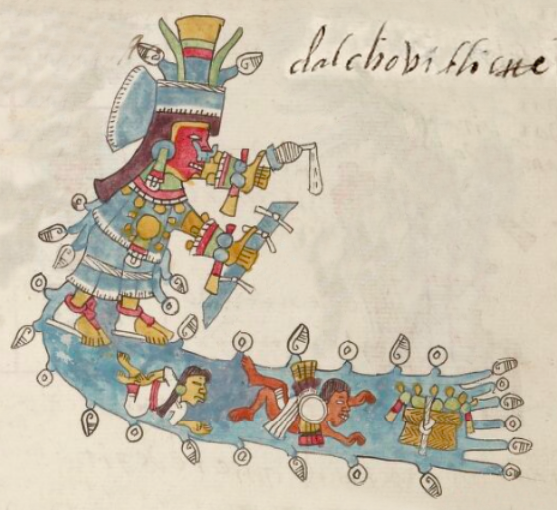Chalchiuhtlicue (TR11v)
This example of the iconographic representation of Chalchiuhtlicue, "Her Skirt is Jade" (or Greenstone). She is the divine force or divinity of flowing ground waters. This portrait shows a figure in profile, facing toward the viewer's right. She has water as her skirt (with white trim) and water in her headdress. Turquoise blue, which is the same color given to water, is the predominant color for this figure. She even holds a staff that is water-colored. At her feet is a large stream of water in which a male and a female try to swim, and there is a large, lidded basket with a white tie around it and a green stone necklace on its lid in this water. The water throws off white droplets or beads and white turbinate shells. The main figure's feet are wearing white sandals with red ties. She wears earrings that appear to be jade signs. She has a turquoise nose ornament, and additional ornamentation in front of her red face (outlined in yellow). The ornamentation in front of her face ends with a spindle loaded with white spun cotton. The deity's hair lis long and dark purple/brown.
Stephanie Wood
Chalchiuhtlicue was a patroness of birth and her powers lay close to running waters. In Aztec imagery her skirt was made of jade stones from which water often flowed. She presided over the day sign 5 cóatl (5 snake) and the trecena Ce ácatl (1 reed). In her manifestation of Acuecueyotl she was the ocean goddess. As Ahuic she became the tips of breaking waves.
Tecciztécatl, lunar deity, was the son of Tlaloc and Chalchiuhtlicue. Huixtocíhuatl, goddess of salt, was Tlaloc’s daughter."> See Mexicolore for more information about Chalchiuhtlicue and her counterpart, Tlaloc, associated with celestial waters. This same article publishes another portrait of Chalchiuhtlicue from the Codex Tonalamatl of the Pochtecs (Féjervary-Meyer).
Eloise Quiñones Keber (Codex Telleriano-Remensis, 1995, 170) notes that Chalchiuhtlicue's "outstretched hands hold items typical of the domain of women, a spindle with a hanging strip of cotton and a blue batten. According to Thelma Sullivan (1982), "these weaving tools, more commonly associated with the deity Tlazolteotl, were also symbolic of human generation" [i.e. fertility]. Additionally, Quiñones Keber paraphrases the annotations on the manuscript as informing the reader as to the fate of those being carried away in the water below Chalchiuhtlicue, who, whether "born rich or poor" would "lose everything" in death.
Stephanie Wood
chalchivitlicue
Chalchiuhtlicue
Stephanie Wood
ca. 1550–1563
Jeff Haskett-Wood
deities, deidades, fuerzas divinas, divinidades, water, agua, goddesses
Chalchiuhtlicue, a deity, a fertility goddess associated with earthly waters, https://nahuatl.wired-humanities.org/content/chalchiuhtlicue
Telleriano-Remensis Codex, folio 11 recto, MS Mexicain 385, Gallica digital collection, https://gallica.bnf.fr/ark:/12148/btv1b8458267s/f48.item.zoom
The non-commercial reuse of images from the Bibliothèque nationale de France is free as long as the user is in compliance with the legislation in force and provides the citation: “Source gallica.bnf.fr / Bibliothèque nationale de France” or “Source gallica.bnf.fr / BnF.”



